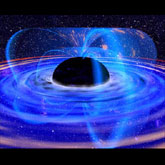Astronomers Glimpse Feeding Of A Galactic Dragon
 A team of radio astronomers has found a cold ring of gas around a supermassive black hole in the fiery nuclear region of quasar galaxy 'QSO I Zw 1,' the most detailed observational evidence yet that gigantic molecular clouds fuel massive star formation in the galactic neighborhood of the black hole. A small fraction of this material might eventually find its way along streamers to the very center, just to be sacrificed to the black hole as fuel to power the brilliant quasar. The ring of gas clouds is likely the site of intense star formation as the clouds collapse under their own gravity, according to the team, and the observation is a significant first step to determining if there is a link between star formation and quasar activity.
A team of radio astronomers has found a cold ring of gas around a supermassive black hole in the fiery nuclear region of quasar galaxy 'QSO I Zw 1,' the most detailed observational evidence yet that gigantic molecular clouds fuel massive star formation in the galactic neighborhood of the black hole. A small fraction of this material might eventually find its way along streamers to the very center, just to be sacrificed to the black hole as fuel to power the brilliant quasar. The ring of gas clouds is likely the site of intense star formation as the clouds collapse under their own gravity, according to the team, and the observation is a significant first step to determining if there is a link between star formation and quasar activity.
Quasars can outshine a trillion suns, and are believed to be the fiercely bright cores of galaxies that harbor black holes weighing in at millions to billions of suns. A black hole, so named because nothing, not even light, can escape its intense gravity once past its boundary, is suspected of being the engine that powers a quasar. While many galaxies have massive black holes lurking in their centers, in quasar galaxies, the black holes 'breathe fire' as they feed on vast amounts of interstellar gas that somehow makes its way into the galactic center. The gas whirls around the black hole before plunging in, like water down a drain. This generates intense friction, heating the gas and causing it to shine brightly.
The ring of gas clouds is about 4,000 light years from the galactic center, rotating around it at about 200 kilometers per second (almost 125 miles/sec.), and contains the mass of more than a billion suns, according to the observation. Despite the unusual optical brilliance of the quasar, these are ordinary characteristics of luminous galaxies, according to the team. Other observations indicate that QSO I Zw 1 is interacting with a neighboring galaxy. Observations of closer galaxies suggest that galactic interactions (collisions and near misses) cause bursts of star formation, and the team is curious about whether such interactions ignite quasar activity as well.
About the Author
NASA Goddard Space Flight Center
 The Goddard Space Flight Center is a major NASA space research laboratory located approximately 6.5 miles northeast of Washington, D.C. in Greenbelt, Maryland, United States.
The Goddard Space Flight Center is a major NASA space research laboratory located approximately 6.5 miles northeast of Washington, D.C. in Greenbelt, Maryland, United States.


